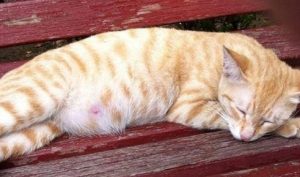Cat owners are often curious about the signs that indicate their cat is about to give birth. Below is a detailed description of these symptoms:
1. Swollen Abdomen and Visible Nipples
-
Prominent Abdominal Distension: As the pregnancy progresses, the cat’s abdomen will become noticeably swollen and may even appear to sag.
-
Visible and Functional Nipples: The nipples will become more prominent and may produce a clear or milky fluid in the days leading up to labor.
2. Nesting Behavior The pregnant cat will start to look for a quiet and comfortable place to prepare for labor. Once a suitable nesting spot is found, the cat may spend more time there, showing reluctance to leave.
3. Loss of Appetite On the day of labor, the cat typically loses its appetite. A sudden refusal to eat can be a significant indicator of impending labor, assuming there are no underlying health issues.
4. Decreased Body Temperature The cat’s body temperature will drop by about 1°C within 12 to 24 hours before labor begins.
5. Restlessness and Rapid Breathing In the hours leading up to labor, the cat may exhibit signs of discomfort and restlessness due to uterine contractions. It may lie on its side in the nest and breathe more rapidly than usual.
6. Increased Water Intake The cat may drink large amounts of water during the intervals between contractions.
7. Vaginal Discharge If a viscous discharge is observed at the vaginal opening, it indicates that labor is imminent, and the cat should be placed back in the nesting box.
8. Timing of Labor Most cats give birth during the early morning or evening, so owners should pay special attention during these periods.
9. Physical and Behavioral Changes The abdomen will grow larger over time, and the cat’s appetite may increase slightly. The breasts will swell, and the nipples will become more pronounced. Close to delivery, the cat may bite off the hair around the nipples and search for a safe place to give birth.
If you observe these signs in your pregnant cat, it’s essential to provide a quiet and comfortable environment for her to deliver her kittens. Ensure that the nesting box is clean and well – prepared. If you have any concerns about the cat’s health or the delivery process, consult a veterinarian for professional advice.

